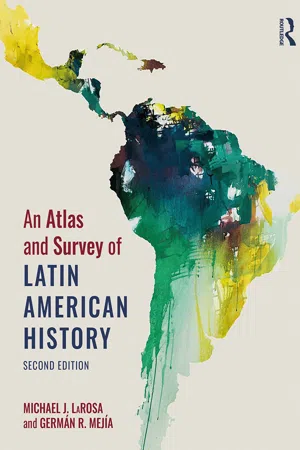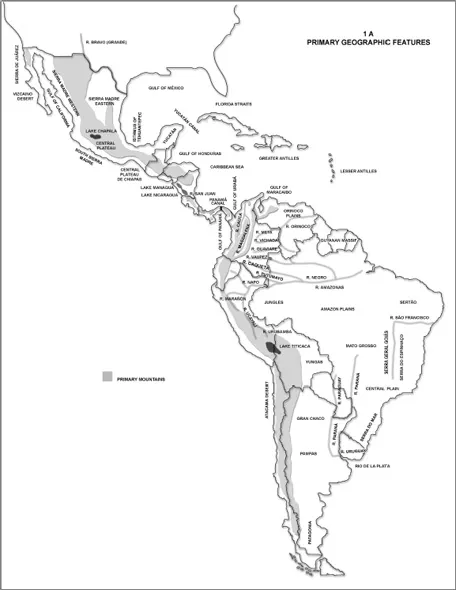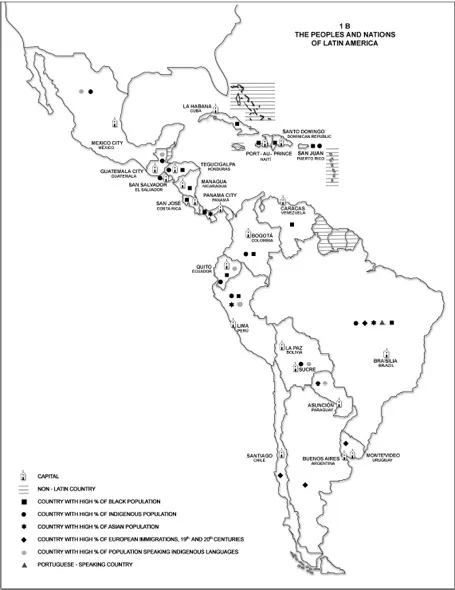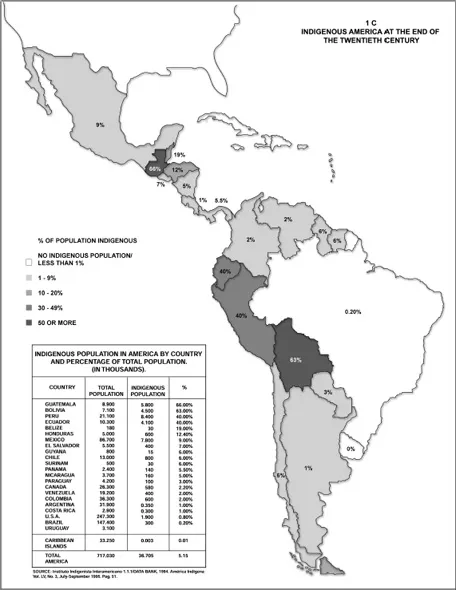![]()
1
The Land and its Peoples
![]()
1A
Primary Geographic Features
Latin American geography is nearly impossible to define in one short essay. The vastness and complexity of “Latin America” comprises virtually all of the geographic characteristics found in the world. There are mountains, far-reaching river systems, deserts, grassy plains, high tropical plateaus (called páramos), jungles, even glaciers. For the purposes of this essay, Latin America will be defined as all territory south of the border that separates the United States and Mexico. The Caribbean islands conquered and colonized by countries with Latin-derivative languages will be included as well; Cuba is defined as Latin America, while Aruba is not. Climates vary from tropical to temperate. The equator bisects South America at Ecuador, Peru, Colombia, and Brazil, but climactic conditions are a function of many factors, including altitude. Thus, the city of Quito, which sits on the equator at 2,800 meters, is cold and damp while Manaus, in Brazil (at about the same latitude), sits along the Amazon River and has a tropical climate.
Latin America consists of approximately 42 million square kilometers, but much of the Latin American continent is not populated by humans. Latin American geography—rivers, mountains, and jungles—has presented major obstacles and opportunities for the development of human civilization. Before the arrival of the European conquerors, Native Americans lived in relative isolation in diverse areas of Latin America. The nomadic Tupi in southeast Brazil had little in common with the Aztecs of the Central Valley of Mexico, or the Caribbean Arawak peoples. These distinct civilizations were shaped, to a large degree, by the surrounding geographic and climactic factors. Europeans, upon arriving in America in 1492, were astounded by the variety of flora and fauna, and the diverse geography of the American continent. They believed that they had “discovered” a sort of Utopia that offered refuge from the wars, famines, and plagues of Europe.
Additionally, Latin America represented a vast array of natural resources that were of paramount importance to the invading Europeans. Silver and gold could be found in Mexico, Peru, Bolivia, and Colombia; sugar adapted easily to the climactic conditions of the Northeast of Brazil and the Caribbean islands; cacao became the principle export of what would become known as Venezuela. The diverse agricultural and mineral wealth reflected the variety of climates and geography in the Latin American region. There are three basic structural divisions that help clarify Latin America’s geography. First, moving from the Atlantic toward the Pacific Ocean, there are the high eastern plains of Brazil and Guyana; the second division is generally referred to as vast interior lowlands, which extend (north–south) from Venezuela to Argentina and conform about five general geographic subdivisions: the llanos (or grassy plains of Venezuela and Colombia), the Amazon flatlands, the Chaco region of eastern Bolivia, the Argentine grasslands known as the Pampas, and the Patagonia plateau. This zone is comprised of the important Orinoco, Amazon, and River Plate river systems and tributaries. Finally, there are the western highlands, which extend from the south of Chile to the north of Mexico and through the Antilles. The Andes mountain range forms the spine of the Latin American continent: the mountains begin in southern Chile, divide in two places in Bolivia, run through Peru and Ecuador, divide again in Colombia, and terminate in Venezuela and Colombia at the Caribbean Sea. Mexico is characterized by vast deserts in the north, and mountains in the south, west, and central regions of the country.
This general outline of Latin American geography hardly reflects the complexity of individual areas. For example, Peru’s geography alone contains a dry western coast influenced by the Pacific Ocean Humboldt current, which brings cold, moist air to the Peruvian coast. Rising up to the immediate east of the coast are the dramatic Andes, with many fertile hamlets, once home to the great Inca civilization. To the east of the Andes lies a vast tropical jungle. Peruvian geography is no more or less complex than that of other nations of Latin America, but the Peruvian case shows that human exigency has tended to overcome and adapt to complex terrain in Peru and in Latin America in general.
The geography of Latin America helps explain the history of the region. It is impossible to speak of any sort of Latin American unification, as geographic reality prevents, for all practical purposes, territorial unity. Thus, the individual personalities and characteristics of the distinct Latin American peoples were shaped by geographic factors, then reshaped by the European conquerors who arrived in the late fifteenth century.
Bibliography
Clawson, David L. 1997. Latin America and the Caribbean Lands and Peoples. New York: McGraw-Hill.
Cunill Grau, Pedro. 1999. “Lageohistoria.” In Para una historia de América Latina, I. Las estructuras, ed. Marcello Carmagnani, Alicia Hernández Chávez, Ruggiero Romano. México, DF: FCE y El Colegio de México.
![]()
1B
The Peoples and Nations
Latin America today is comprised of 20 politically independent nations, and the people who inhabit the region are as diverse as the geography that tends to separate them.1 Two-thirds of all Latin Americans live in the three most populous countries, Brazil, Mexico, and Colombia. The political boundaries are somewhat artificial constructs, developed primarily by the Spaniards and Portuguese as a way of ordering and controlling vast territories and millions of people. During the nineteenth century, the newly independent nations of Latin America constructed territorial boundaries that roughly resembled the Spanish–Portuguese delineations. The boundaries would reflect the priorities of Europeans in America; thus, the territorial division of Latin America in the early republic period began with unfortunate consequences for the people. For example, Aymara-speaking peoples in the south of Peru were divided by a political boundary: those living to the north identified themselves as Peruvians, whereas those to the south referred to themselves as Bolivians. The same occurred with indigenous peoples living along the borders between Ecuador and Peru, Ecuador and Colombia, and Mexico and Guatemala.
Latin Americans are not a singular people, and the distinct cultures and histories of the immense Latin American region defy clear or facile definitions. It is impossible to assign a general physiognomic characterization to “Latin Americans.” The people are descendants of Native Americans, Europeans, Africans, and people of Middle Eastern and Asian origin. The distribution of these peoples and their descendants varies throughout the region and reflects a dynamic sociopolitical and economic exchange over a lengthy time period. The largest concentrations of Asians in Latin America are found in Peru (mostly descendants of Chinese workers who migrated in the nineteenth century) and Brazil (mostly Japanese in origin, who migrated to Brazil and settled primarily in the city of São Paulo in the first half of the twentieth century, particularly in the interwar years). People of African descent are concentrated in the northeast of Brazil (where they were forced to work as slaves during the sugar plantation boom of the sixteenth and seventeenth centuries), on the north coast of South America, the northern Pacific coast of South America (including the Colombian Chocó, the lowlands of Ecuador, and the northwestern region of Peru), and the Caribbean islands of Cuba, Puerto Rico, and Hispaniola (which comprises the nations of Haiti and the Dominican Republic). Large concentrations of Native Americans are found in the highlands of Guatemala, Peru, Bolivia, Ecuador, and Paraguay. Significant concentrations of Europeans are found in Uruguay, Argentina, Brazil, and the major metropolitan areas of most other Latin American countries.
The role of the Roman Catholic Church has been extraordinary in shaping Latin America’s diverse culture: most people still identify themselves, nominally at least, as Catholic, though the growth of evangelical Protestantism in the region has been remarkable, especially in the past 30 years in Chile, Brazil, and Central America. In terms of language, Portuguese is spoken by about 210 million residents of Brazil, while Spanish is dominant in the rest of Latin America. However, large percentages of the populations of Peru, Bolivia, and Guatemala speak Native American languages, including Quechua, Aymara, and Quiché. The official language of Paraguay is not Spanish but Guarani. Haitians speak Haitian creole.
Latin America, it is important to note, is a remarkable melting pot—more so, perhaps, than the United States. Most Latin Americans, culturally and racially, fall somewhere “in between.” Categories that are normally assigned in the United States (black or white, for example) fail to capture the reality of Latin American mestizaje, or race-mixing, over time. The nature of contact and conquest, the number and influence of Native American communities, and the African presence all influence the contour of mestizaje in Latin America and make it impossible to draw exact definitions when discussing the Latin American people. Yet, though racially mixed over time and place, social (and racial) segregation continues to pose historic challenges to Latin American citizens and societies.
Note
Bibliography
Asociación Latinoamericana de Estudios Afroasiaticos (ALADAA). 1983. Asia y África en América Latina. Tunja: Universidad Pedagógica y Tecnológica de Colombia.
Stein, Stanley, and Barbara Stein. 1970. The Colonial Heritage of Latin America. New York: Oxford University Press.
![]()
1C
Indigenous America at the End of the Twentieth Century
No one knows for certain how many Native Americans lived in the territory called Latin America before the arrival of the Europeans. It is known that tens of millions of natives died as a result of European disease, dislocation, excessive work, and de facto enslavement by the Spaniards and Portuguese. The colonial structure in Latin America relegated indigenous culture to a secondary plane—in fact, in many places, Native Americans were forced to adopt the culture, religion, language, and customs of their European masters and were told to forget about indigenous customs, considered (by Europeans) backward at best and barbaric in the most extreme interpretation.
It was not until the early twentieth century that a clear celebration of indigenous culture took shape in...



